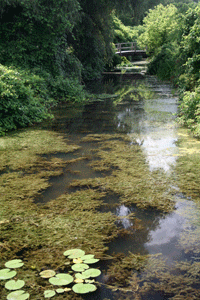It’s back. To fund the eradication of hydrilla verticillata, an invasive aquatic species that first reared its head last fall, a local environmental task force has requested $700,000 to $1 million in funding from New York state.

First spotted in August, hydrilla creates toxic blue algae harmful to local wildlife. In October, Mayor Carolyn Peterson declared an environmental emergency to address the infestation of hydrilla, and a week later, as recommended by the Cayuga Inlet Hydrilla Task Force, Allied Biological, a lake management consulting company based in the Northeast, administered Herbicide Aquathol X to prevent the plant’s spread via reproduction. Portions of the Inlet were reopened to boat traffic two days later.
Though the hydrilla is presently in a state of dormancy, Sharon Anderson, environmental program leader for the Cornell Cooperative Extension of Tompkins County, said the mild winter has done very little to impact the plant’s growth. The invasion is expected to be worse, she said, because there was not a harsh winter to kill the hydrilla’s exposed tubers.
Roxy Johnston, watershed coordinator for the City of Ithaca’s Water Treatment Plant, said the task force asked the state for funds Jan. 31, but members are unsure if the state will help finance the spring’s herbicide treatment for hydrilla removal. Johnston said she is hopeful the state will at least contribute some money to the project.
“The cost burden and the coordination burden really is overwhelming for any single municipality or even county,” Johnston said. “So we’re asking the state for some relief.”
Though hydrilla is mostly an environmental issue, if it is left untreated, its presence could damage the local economy. The revenues made off the lake will quickly disappear if the species is permitted to continue growing because the water could become solid hydrilla, Johnston said.
If this occurs, Johnston said, locals will have to pay to keep the channels open while the tourism profits drop and the real estate value of the area declines.
“If the Inlet becomes solid hydrilla, which is what happens if we don’t do something, there’s not going to be boat traffic in and out, and it won’t be attractive or desirable,” Anderson said. “So it’s a loss for everyone.”
If the state refuses to provide assistance, Johnston said, the task force will look elsewhere for funding the elimination of the invasive species. The management team is currently applying for grants to fund the hydrilla removal, she said, as the herbicide required to kill the tubers is costly.
“The cost is high per acre period, with whichever direction you choose to go,” Johnston said. “We have quite a few number of acres we have to treat. We’re looking at a maximum of 66 acres.”
Johnston said there are before and after tests to ensure the herbicide will cause no unwanted side effects in the water. Also, she said, money must be allocated to raising public awareness concerning the project.
Dave Adams, regulatory coordinator of the Department of Environmental Conservation, said the herbicide treatment in October was successful even though it did not entirely eradicate the plant’s infestation.
“With treatment and monitoring, we can remove the overall vegetation’s density and extent, but it will take a couple of years,” Adams said.
While it is speculated that it will take five years to fully eliminate the hydrilla, Johnston said, the process could take up to seven years to finish.







